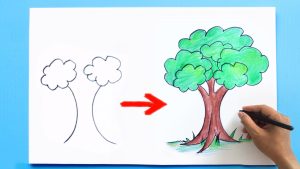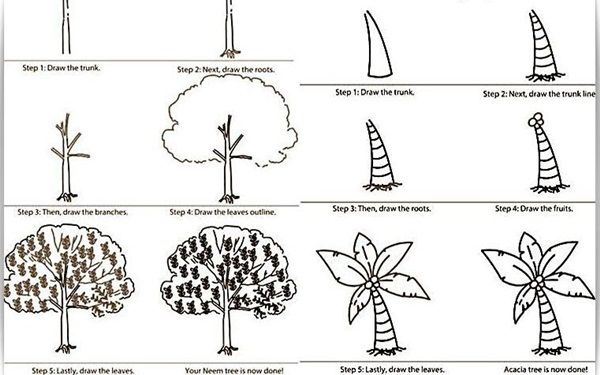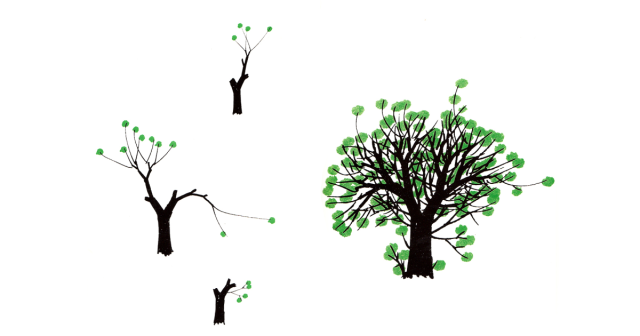Tree Drawing is a delightful and creative endeavor that allows individuals to express their artistic flair while capturing the essence of nature. Begin by sketching the trunk, ensuring it stands sturdy and rooted in the ground. Branch outwards, varying the lengths and angles to create a harmonious balance. Pay attention to the intricate details of the leaves or needles, whether they are delicate and serrated or broad and smooth.

Exploring the Art of Tree Drawing
Trees, with their majestic forms and intricate details, have captivated artists for centuries. Drawing trees can be a rewarding challenge, offering endless opportunities for exploration and expression. Let’s delve into the art of tree drawing, from capturing their basic structure to infusing them with symbolism and emotion.
Observing the Anatomy of a Tree:
Before putting pencil to paper, take some time to truly observe a tree. Notice how the trunk tapers upwards, how branches fork and twist, and how the foliage creates a canopy of light and shadow. Pay attention to the bark’s texture, the gnarled roots, and the delicate veins of the leaves.
Capturing the Form:
Start with loose, gestural lines to sketch the tree’s overall shape and proportions. Don’t worry about precision at this stage; focus on capturing the essence of the tree’s posture and movement. Once you have a basic framework, you can refine your lines and add details like branches, twigs, and leaves.
Light and Shadow:
Light and shadow play a crucial role in creating depth and dimension in your drawing. Observe how sunlight filters through the leaves, casting dappled patterns on the ground. Use shading techniques to emphasize these areas of contrast, adding depth and texture to your tree.
Experimenting with Different Media:
Pencils, charcoal, ink, and even crayons can be used to create stunning tree drawings. Each medium has its own unique qualities that can be used to evoke different moods and textures. For example, charcoal can be used to create dramatic, expressive drawings, while ink washes can create a sense of ethereal beauty.
Adding Symbolism and Emotion:
Trees can be imbued with powerful symbolism, representing strength, resilience, growth, and even wisdom. Consider the type of tree you are drawing and what it might symbolize. A gnarled oak might represent longevity and perseverance, while a delicate willow might evoke feelings of melancholy and grace. Use your drawing to convey the emotions and ideas that the tree inspires you.
Finding Inspiration:
Immerse yourself in the work of other artists who have mastered the art of tree drawing. From the detailed botanical illustrations of Audubon to the evocative landscapes of Van Gogh, there’s a wealth of inspiration to be found in the works of others.

A Beginner's Guide to Drawing Trees
Trees, with their towering presence and intricate details, have captivated artists for centuries. But if you’re a beginner, capturing their grandeur on paper can seem daunting. Fear not! This guide will equip you with the basic tools and techniques to bring these majestic giants to life on your canvas.
Step 1: Observe the Anatomy of a Tree
Before diving in, take a moment to truly observe a tree. Notice how the trunk tapers upwards, how branches fork and twist, and how the foliage creates a canopy of light and shadow. Pay attention to the bark’s texture, the gnarled roots, and the delicate veins of the leaves.
Step 2: Capture the Form with Light Lines
Start with loose, gestural lines to sketch the tree’s overall shape and proportions. Don’t worry about precision at this stage; focus on capturing the essence of the tree’s posture and movement. Imagine the tree as a collection of simple shapes like ovals and cylinders for the trunk and branches, and then connect them with flowing lines.
Step 3: Refine Your Lines and Add Details
Once you have a basic framework, you can refine your lines and add details like branches, twigs, and leaves. Use light, short strokes for delicate elements like leaves and heavier lines for thicker branches. Remember, trees are rarely symmetrical, so embrace the natural asymmetry that makes them unique.
Step 4: Breathe Life with Light and Shadow
Light and shadow play a crucial role in creating depth and dimension in your drawing. Observe how sunlight filters through the leaves, casting dappled patterns on the ground. Use shading techniques like hatching and cross-hatching to emphasize these areas of contrast, adding depth and texture to your tree.
Step 5: Experiment with Different Media
Pencils, charcoal, ink, and even crayons can be used to create stunning tree drawings. Each medium has its own unique qualities that can be used to evoke different moods and textures. For example, charcoal can be used to create dramatic, expressive drawings, while ink washes can create a sense of ethereal beauty.

Tree Drawing Techniques Unveiled
Trees, with their towering presence and intricate details, have captivated artists for centuries. But capturing their grandeur on paper can seem daunting, especially for beginners. Fear not! This guide will unveil some fundamental techniques to bring these majestic giants to life on your canvas:
1. Observe the Anatomy of a Tree:
Before diving in, take a moment to truly observe a tree. Notice how the trunk tapers upwards, how branches fork and twist, and how the foliage creates a canopy of light and shadow. Pay attention to the bark’s texture, the gnarled roots, and the delicate veins of the leaves.
2. Capture the Form with Simple Shapes:
Start with loose, gestural lines to sketch the tree’s overall shape and proportions. Don’t worry about precision at this stage; focus on capturing the essence of the tree’s posture and movement. Imagine the tree as a collection of simple shapes like ovals and cylinders for the trunk and branches, and then connect them with flowing lines.
3. Refine Your Lines and Add Details:
Once you have a basic framework, you can refine your lines and add details like branches, twigs, and leaves. Use light, short strokes for delicate elements like leaves and heavier lines for thicker branches. Remember, trees are rarely symmetrical, so embrace the natural asymmetry that makes them unique.
4. Breathe Life with Light and Shadow:
Light and shadow play a crucial role in creating depth and dimension in your drawing. Observe how sunlight filters through the leaves, casting dappled patterns on the ground. Use shading techniques like hatching and cross-hatching to emphasize these areas of contrast, adding depth and texture to your tree.
5. Experiment with Different Media:
Pencils, charcoal, ink, and even crayons can be used to create stunning tree drawings. Each medium has its own unique qualities that can be used to evoke different moods and textures. For example, charcoal can be used to create dramatic, expressive drawings, while ink washes can create a sense of ethereal beauty.
6. Infuse Your Tree with Symbolism and Emotion:
Trees can be imbued with powerful symbolism, representing strength, resilience, growth, and even wisdom. Consider the type of tree you are drawing and what it might symbolize. A gnarled oak might represent longevity and perseverance, while a delicate willow might evoke feelings of melancholy and grace. Use your drawing to convey the emotions and ideas that the tree inspires you.

Drawing Trees Throughout the Year
Absolutely! Drawing trees throughout the year offers a fascinating journey through nature’s ever-changing canvas. Each season presents unique challenges and opportunities to capture the essence of these majestic beings. So, grab your pencils, unleash your creativity, and let’s delve into the world of seasonal tree drawing!
Springtime Symphony:
Spring is a time of rebirth and renewal. Trees burst forth with vibrant green leaves, delicate blossoms paint the branches, and the air hums with life. Capture this energy by using light, loose strokes and fresh, bright colors.
- Focus on the delicate details: Use fine lines to render the veins on leaves, the soft fuzz of new buds, and the tiny blossoms dancing in the breeze.
- Embrace the play of light and shadow: The dappled sunlight filtering through the leaves creates a beautiful dance of light and shadow. Use hatching and cross-hatching techniques to bring out this interplay.
- Let the colors sing: Spring is a riot of colors! Experiment with soft greens, light yellows, and delicate pinks to capture the fresh palette of the season.
Summertime Splendor:
Summer paints the trees in a lush, verdant cloak. Leaves reach their peak size and density, casting cool shadows on the ground below. Capture this abundance by using bold strokes and rich, saturated colors.
- Emphasize the texture of the leaves: Use layering and stippling techniques to create the rough, textured surface of summer foliage.
- Play with negative space: The gaps between leaves and branches can be just as interesting as the leaves themselves. Use negative space creatively to add depth and dimension to your drawing.
- Capture the vibrant hues of summer: From the deep emerald greens to the golden yellows and fiery oranges, let the colors of summer burst forth from your drawing.
Autumnal Tapestry:
Autumn transforms trees into a fiery spectacle. Leaves blaze with reds, oranges, yellows, and browns, creating a breathtaking tapestry against the crisp autumn air. Capture this transformation by using a mix of loose and controlled strokes and a warm, vibrant color palette.
Finding Inspiration in Tree Drawings
Finding inspiration in tree drawings can be a captivating journey, opening your eyes to the beauty and symbolism these majestic giants hold. Whether you’re an experienced artist or just starting out, immersing yourself in the world of tree art can spark new ideas and ignite your creativity. Here are some ways to find inspiration:
1. Explore the Masters:
- Audubon’s Botanical Illustrations: Dive into the intricate details of leaves and branches in John James Audubon’s stunning botanical illustrations. His meticulous attention to form and texture will inspire you to capture the essence of each tree species.
- Van Gogh’s Evocative Landscapes: Immerse yourself in the swirling energy and vibrant colors of Vincent van Gogh’s landscapes. His expressive brushstrokes and bold use of color will show you how trees can be used to convey emotions and moods.
- Japanese Woodblock Prints: Discover the stylized beauty of Japanese woodblock prints, where trees often hold symbolic meaning. Learn how to use simplified forms and bold lines to create striking compositions.
2. Look Beyond the Canvas:
- Nature Walks: Take a walk in your local park or forest and observe the trees around you. Pay attention to the interplay of light and shadow, the different textures of bark and leaves, and the unique shapes and forms of each tree.
- Travel and Photography: Travel to different regions and capture the unique tree species you encounter. Photographs can be valuable references for your drawings, allowing you to study details later.
- Museums and Botanical Gardens: Visit museums and botanical gardens to see a variety of tree specimens and artwork depicting them. Immerse yourself in the diversity of trees and find inspiration in unexpected places.
3. Experiment with Different Techniques:
- Try new media: Don’t limit yourself to pencils and charcoal. Experiment with ink washes, watercolors, or even mixed media to create different textures and effects.
- Play with perspective: Get down low or climb up high to see trees from different angles. This can change the way you perceive their form and create unique compositions.
- Focus on details: Zoom in on a specific part of a tree, like the bark texture, a cluster of leaves, or a gnarled branch. This can help you appreciate the intricate beauty of nature’s smallest details.
Crafting Realistic Tree Art
Crafting realistic tree art requires a keen eye for detail and a passion for capturing the essence of nature. It’s about going beyond simple representation and breathing life into these majestic giants on your canvas. Here are some tips and techniques to help you create stunningly realistic tree art:
1. Observe and Understand the Anatomy:
Before picking up your brush, spend time studying real trees. Notice how the trunk tapers upwards, how branches fork and twist, and how the leaves form a canopy of light and shadow. Pay attention to the bark’s texture, the gnarled roots, and the delicate veins of the leaves. Understanding the anatomy of a tree will allow you to recreate its form and structure with accuracy.
2. Master the Art of Light and Shadow:
Light and shadow play a crucial role in creating depth and dimension in your artwork. Observe how sunlight filters through the leaves, casting dappled patterns on the ground. Use shading techniques like hatching, cross-hatching, and stippling to emphasize these areas of contrast, adding depth and texture to your tree.
3. Capture the Essence of Different Seasons:
Each season presents a unique opportunity to capture the essence of a tree. Springtime bursts with vibrant green leaves and delicate blossoms, while summer’s lush foliage offers a play of light and shadow. Autumn paints the trees in a fiery tapestry of reds, oranges, and yellows, and winter reveals their stark beauty in bare branches and intricate patterns. Adapt your techniques and color palette to reflect the seasonal changes.
4. Experiment with Different Media:
Pencils, charcoal, ink, and even crayons can be used to create stunning tree art. Each medium has its own unique qualities that can be used to evoke different moods and textures. For example, charcoal can be used to create dramatic, expressive drawings, while ink washes can create a sense of ethereal beauty.
5. Don’t Forget the Details:
The little things can make a big difference in creating realistic tree art. Pay attention to details like the veins on leaves, the roughness of bark, and the tiny twigs and branches. These details will add depth and interest to your drawing and make it feel truly alive.
Perfecting the Details in Your Tree Sketches
Elevating tree sketches from good to great is all about refining the details, those subtle nuances that breathe life and character into your artwork. Here are some tips and tricks to help you take your tree sketches to the next level:
1. Master the Art of Linework:
- Vary your line weight: Use thicker lines for the trunk and main branches, and gradually taper to lighter lines for smaller branches and twigs. This creates a sense of depth and perspective.
- Experiment with different line textures: Use short, quick strokes for rough bark, and long, flowing lines for smooth branches. Consider using stippling or cross-hatching techniques for added texture and depth.
2. Capture the Dance of Light and Shadow:
- Observe how light interacts with the leaves: Notice how sunlight filters through the foliage, creating dappled patterns on the ground and casting shadows on the leaves themselves. Use shading techniques to replicate these effects, adding depth and dimension to your drawing.
- Don’t forget the subtle shadows: Pay attention to the shadows cast by branches on the trunk and the subtle shading under leaves. These small details can make a big difference in the overall realism of your tree sketch.
3. Bring the Bark to Life:
- Study the bark’s texture: Different tree species have unique bark textures. Rough, gnarled bark can be depicted with short, scratchy lines, while smooth bark can be rendered with long, flowing strokes.
- Don’t shy away from imperfections: Trees are rarely perfect. Include cracks, knots, and other imperfections in your bark to add realism and character to your drawing.
4. Embrace the Beauty of Leaves:
- Pay attention to leaf shape and size: Different tree species have distinct leaf shapes and sizes. Take the time to observe the leaves of the tree you’re drawing and accurately replicate their forms.
- Don’t forget the veins: Leaves have intricate vein patterns that add detail and interest. Use fine lines to delicately render these veins, especially on larger leaves.
5. Refine your Composition:
- Think about negative space: The spaces between branches and leaves are just as important as the tree itself. Use negative space effectively to create a balanced and pleasing composition.
- Consider the background: What surrounds the tree? A simple background can help your tree stand out, while a more detailed background can add context and create a sense of place.
Frequently Asked Questions (FAQs)
Practice regularly, study anatomy, observe real-life subjects, and seek feedback from other artists. Online tutorials and classes can also be valuable.
Start with quality pencils, sketchbooks, erasers, and a sharpener. As you progress, you may explore different mediums like colored pencils, markers, or digital tools.
Experiment with different techniques, subjects, and mediums. Your style will emerge over time as you incorporate elements that resonate with you personally.




















